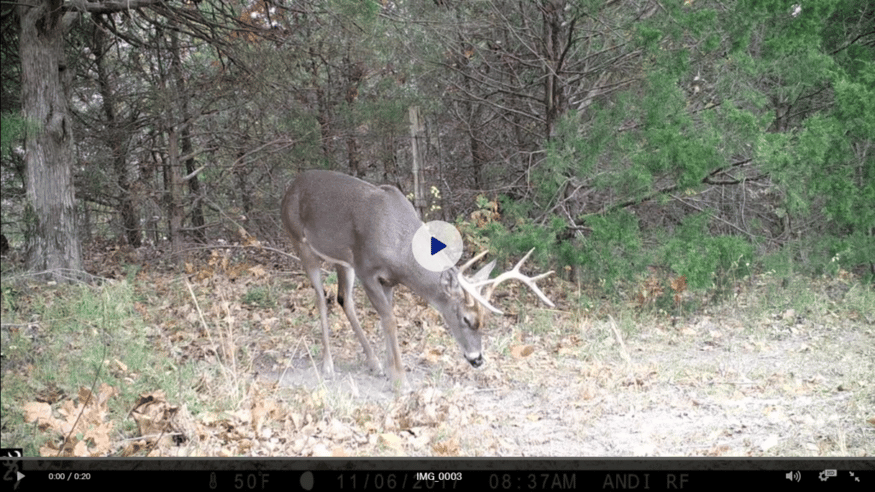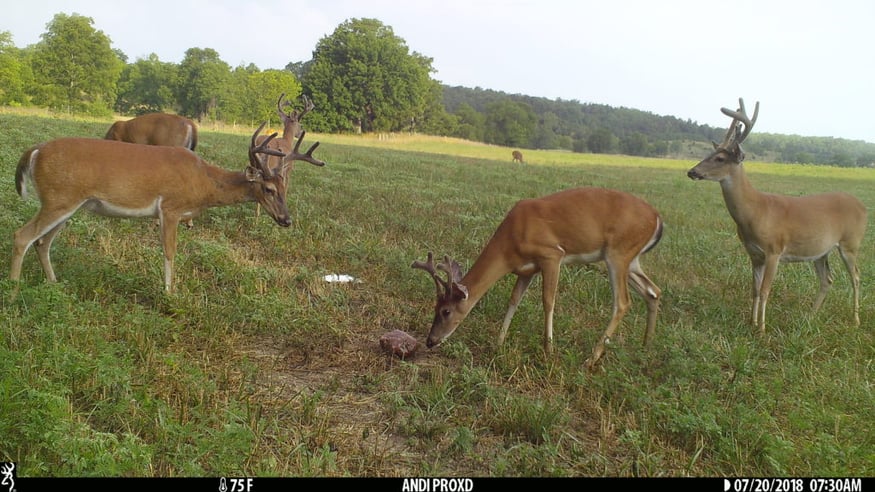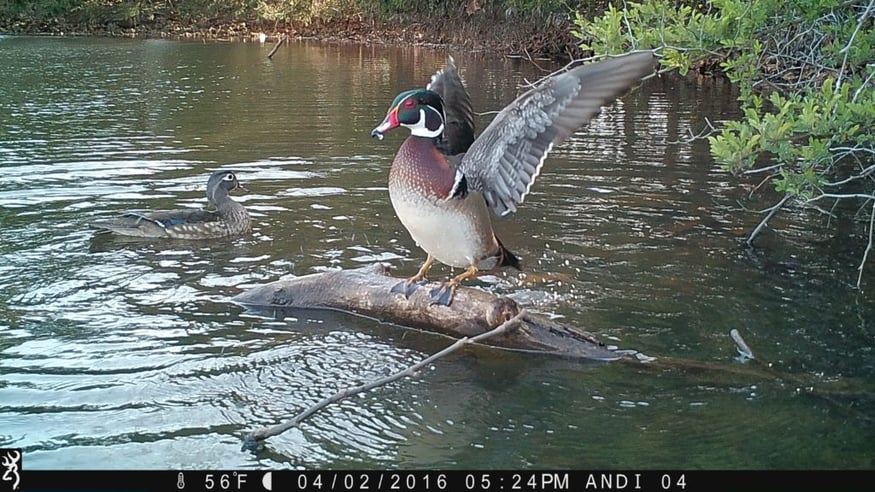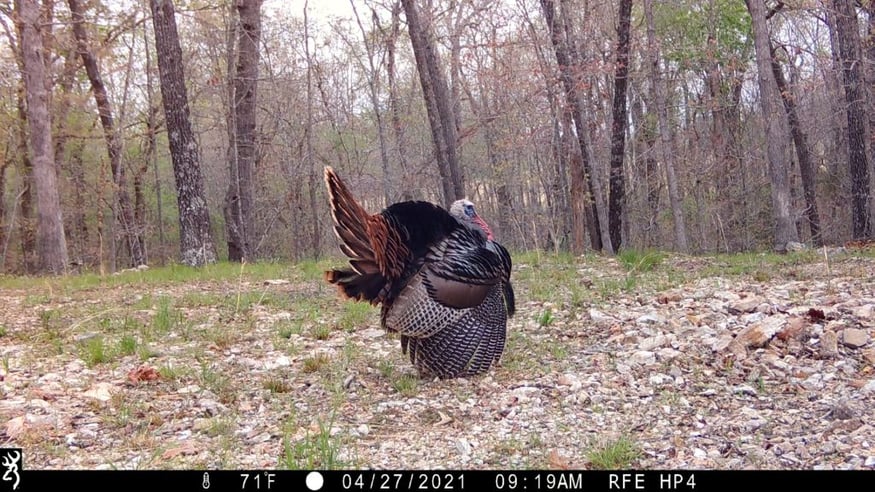How To Make Up For Slow Trigger Speed On Your Trail Camera?
Understanding Trail Camera Settings
February 14, 2022
Trail photographic camera settings can be disruptive. What are the different modes and when should they be used? Hither are ten exciting trail photographic camera features to know about.

In this post, Andrea Rothove—gorging hunter, outdoor enthusiast, and hunting teacher—talks well-nigh common trail camera settings. Andrea is the founder of Huntress View, a hunting website and blog that helps women acquire almost hunting and the outdoors from other women. She also works for Browning Trail Cameras. Here Andrea shares expertise most heady trail cam features on most cameras and what situations to utilise them. Trail camera engineering has greatly improved over the years and there are more settings and features than e'er earlier, ofttimes packed into merely 1 trail camera! Flare-up Mode, Timelapse Mode, videos with audio, adjustable trigger speed, and more than. But what does information technology all hateful and what are the best scenarios for using these different modes? Below, I'll share ten of the most common features that most trail cameras accept and expand on some of the more than advanced features, as well as explicate different situations that each of the settings are best used for. This is the most common and most basic setting that all trail cameras have. This manner will take still images of animals during both day and night when triggered by movement in forepart of the camera. Scenario: This is neat for whatever type of trail camera use, whether you're using information technology for hunting purposes, surveillance, or merely leisure. Another style that almost all trail cameras now accept is video mode. This way will take video clips of animals during both day and dark when triggered by movement in front end of the camera. The length of the video unremarkably depends on what you choose to set it on: 5 seconds, 30 seconds, etc. Scenario: Video mode is nifty when you desire to get a trivial more than intel than a still image tin can provide. For case, if yous get a video of a whitetail buck in deer season close to the rut, a video with sound allows you to get a better thought of the buck's behavior. Was he grunting, casually strolling by the photographic camera, peradventure chasing a doe? This characteristic allows a daytime video clip to keep recording as long every bit the camera detects motility during filming. If the camera no longer detects movement, it will end the video clip at the designated time called in the setup menu. Scenario: This feature is corking to better observe an creature'south behavior if they're in forepart of the photographic camera longer than y'all have it designated to take a video clip. It's as well bang-up in a surveillance situation. For example, say y'all have your photographic camera gear up to take a ten-2nd video every infinitesimal. If someone were to be trespassing or breaking into your abode, chances are they'll be in front of the camera longer than the x seconds. Instead of waiting for the camera to have another video if information technology detects movement once again in 1 minute, the camera in Smart IR Video mode volition go on to record. In this scenario, you lot'll likely become better identifying data of the trespasser than in regular video mode. Timelapse mode will have images throughout the day based on a selected interval of time. For case, if you have it fix to take an prototype every 10 seconds in Timelapse way, it volition take an paradigm every ten seconds throughout the day, regardless of whether in that location is movement in front of the photographic camera. These images tin then be viewed via software provided by the trail camera company that allows you lot to rapidly view the images in chronological society like to watching a video. Browning Trail Cameras likewise has a Timelapse+ Mode, which operates the same as described in a higher place, but it will also take a pic when anything crosses the camera'due south detection zone, as if information technology were in normal photograph mode. Scenario: Timelapse and Timelapse+ mode is perfect to use when you demand to watch a larger expanse, like a wide-open field. In this fashion, you lot can take hold of images of animals out in the field that are exterior of the photographic camera's detection zone and not know that they were there otherwise. This is great for deer hunters determining where to hang a trail camera in photo or video mode, where to gear up a tree stand or basis bullheaded, etc. This setting is used while in photo mode, only instead of taking merely one image when the photographic camera is triggered, it will take multiple images. For example, Browning Trail Cameras has a "Rapid Fire" setting that, when selected, will take up to eight images (the number of images is determined by you) when the photographic camera is triggered, instead of just one. Browning Trail Cameras offers an SD Carte Direction feature that, when the SD carte is full, the photographic camera will brainstorm to erase the oldest pictures or videos on the SD bill of fare and overwrite with the newer images or videos. This allows you to always take the most electric current images/videos on your SD carte du jour. If yous cull not to turn this setting on, the SD card will no longer take images or videos in one case it is total. Scenario: If you're using your trail photographic camera to scout for hunting purposes but you may not be able to brand it back to the field to swap SD cards earlier it fills upwards, turning this characteristic on will allow you to always accept the most current images and videos so y'all know the animal's recent patterns and behaviors. Just like the name suggests, this feature allows you to change the trigger speed on your trail camera within a pre-determined range. For example, the Browning Recon Force Elite HP4 trail camera allows you to suit the trigger speed from 0.1 to 0.seven seconds. Some trail camera models allow y'all to adjust the detection range as well as extend information technology out a little further to capture images of wild fauna further abroad than what the preset detection zone volition capture. Scenario: Fields and more open areas are a expert location for your trail camera when extending the detection range out further. A shorter length of detection range is dandy in the woods. Browning Trail Cameras offer two adjustable IR flashes on most of their trail camera models: Power Save and Long Range. This allows yous to adjust according to your trail camera location. Ability Salve will produce an IR wink that is a petty more than dim and Long Range will extend the IR flash out further. Scenario: When you lot place your trail cameras in the forest, Power Salve IR flash mode works great considering you are watching a smaller area with your trail photographic camera. A field is the perfect location to set your trail camera's IR flash to Long Range way since it's more open up and you can see further. This feature allows the user, when operating the camera in Photo Mode or Video Mode, to select a starting time and stop time to control the time period the camera triggers and captures images/videos. Cellular trail cameras are extremely popular every bit well and have a few unique settings (aside from the ones mentioned above) that users should know about. Browning Trail Cameras' Defender Wireless cellular camera has an app called Strike Forcefulness Wireless that allows you to change the camera's settings directly through the app. The settings mentioned above are all included and can be controlled via the app, merely there are a few different settings within the app that have to practise with how and when you want to view the images/videos from your cellular photographic camera. This allows you lot to choose the times that you want to take images/videos sent to your phone from your cellular photographic camera. You can gear up to viii different times for content to be sent to y'all via the Strike Force Wireless app. This lets you cull whether to have your images/videos sent to y'all by the schedule you selected in the "Camera Sync Schedule" or sent to you "immediately." If yous select "immediately," the images/videos will exist sent to your telephone in real fourth dimension. This is a great characteristic that allows you to create unlike image categories, such as "Whitetail," "Turkeys," etc. You can then select an epitome and add it to a corresponding category so you keep your images organized how y'all wish. With so many different trail camera features beingness introduced as engineering science advances, it may seem a trivial overwhelming when choosing how and when to use each one. Hopefully my information above helps you when choosing which features to use when setting upwards your adjacent trail photographic camera, no matter the scenario! By Andrea Rothove, Browning Trail Cameras representative and founder of Huntress View. Got some swag-worthy photos snapped from your trail cam? Submit them to our Redmond Chase photo competition! Each calendar month we selection our ii favorite photos (must include any visible Redmond Hunt production) for a Reconyx Camera or pair of Vortex Diamondback 10×42 binocs. Or if your moving-picture show gets the most fan votes for the calendar month, you'll win an Outdoor Edge/Bays Rock gift packet! Oh, and we also take a monthly random-entry cartoon where one photograph is chosen for a Browning trail camera. So what are you lot waiting for? View, vote on, and enter photos hither! Or watch the video below to larn more about the contest. Copyright © Redmond Hunt. All rights reserved. 10 Common Trail Camera Settings
1. Photo Fashion
2. Video Mode

iii. Smart IR Video
4. Timelapse & Timelapse+ Mode

5. Burst Mode
 Scenario: Flare-up fashion is great when yous place a camera in a location that you await animals to be moving speedily through the camera's detection zone and you would like to get more than just 1 image of them for meliorate intel. A location where an creature will be feeding and could be in front end of the camera for longer periods of time would non be a good option for this setting.
Scenario: Flare-up fashion is great when yous place a camera in a location that you await animals to be moving speedily through the camera's detection zone and you would like to get more than just 1 image of them for meliorate intel. A location where an creature will be feeding and could be in front end of the camera for longer periods of time would non be a good option for this setting. half dozen. SD Bill of fare Management
7. Adjustable Trigger Speed
 Scenario: You don't always have to take a super-fast trigger speed in order to have a great prototype. Keep in mind the location of your camera when selecting the trigger speed. For case, slowing the trigger speed downwards a piddling to 0.7 seconds may be a better selection for trail cameras over scrapes, minerals, and food sources where you lot expect animals to be coming in at a slower pace. If you wait animals to move through the detection zone more speedily, alter it to the quicker 0.1 trigger speed.
Scenario: You don't always have to take a super-fast trigger speed in order to have a great prototype. Keep in mind the location of your camera when selecting the trigger speed. For case, slowing the trigger speed downwards a piddling to 0.7 seconds may be a better selection for trail cameras over scrapes, minerals, and food sources where you lot expect animals to be coming in at a slower pace. If you wait animals to move through the detection zone more speedily, alter it to the quicker 0.1 trigger speed. 8. Adjustable Detection Ranges
9. Adaptable IR Flash
10. Capture Timer
 Scenario: Many turkey hunters use trail cameras to help lookout for turkeys, but since turkeys roost at night, you lot won't be getting whatever nighttime images of turkeys. In this instance, you could select your trail camera to begin taking images or videos at a selected fourth dimension in the morning time and have it end at a selected time in the evening. This saves both battery life and SD carte space!
Scenario: Many turkey hunters use trail cameras to help lookout for turkeys, but since turkeys roost at night, you lot won't be getting whatever nighttime images of turkeys. In this instance, you could select your trail camera to begin taking images or videos at a selected fourth dimension in the morning time and have it end at a selected time in the evening. This saves both battery life and SD carte space! Additional Cellular Trail Camera Settings
i. Camera Sync Schedule
2. Thumbnail Upload
3. Categories
Rock the Hunt Trail Cam Contest
 Demand some great products to concenter deer and other critters to your trail cam and get more awesome photos? Effort our Redmond Hunt deer mineral products with 60+ trace minerals. Deer love natural Trophy Rock, Four65, and Ruddy Bomb. Click below to purchase and start attracting animals to your mineral site! Don't have a site yet? Read this article for v easy steps to prepare one upwards.
Demand some great products to concenter deer and other critters to your trail cam and get more awesome photos? Effort our Redmond Hunt deer mineral products with 60+ trace minerals. Deer love natural Trophy Rock, Four65, and Ruddy Bomb. Click below to purchase and start attracting animals to your mineral site! Don't have a site yet? Read this article for v easy steps to prepare one upwards. 
Source: https://blog.redmondhunt.com/trail-camera-settings
Posted by: norrisrues1974.blogspot.com

0 Response to "How To Make Up For Slow Trigger Speed On Your Trail Camera?"
Post a Comment